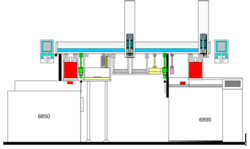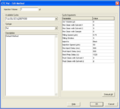Polymers
From LEAP

| Polymers |
| Application Type | |
| Sample Prep and Inject | |
| Application ID | |
| Sample | |
| Description | |
| Polymer Analysis |
Contents |
Overview
Chemical analysis of polymers, as well as other forms of analysis such as viscosity and other tests are a necessary part of polymer development, as well as QC processes during manufacture. Polymers are generally solids when in the final product, and thus are not amenable to such analysis unless they can be first liquefied. Preparation for analysis requires multiple stages of treatment frequently with heated reaction and cooling steps prior to introduction into a detector such as a GC. Such processes are lengthy, time-critical and labor intensive to perform manually. They frequently involve handling of caustic or toxic reagents. There is a strong case therefore, for automation of such processes.
LEAP has broken new ground in one such application, where the complexities of this type of sample preparation have been fully automated using an HTX2H in the configuration shown below:
Significant Markets
- Polymer Manufactures
- Biodiesel Blenders
- Polymer Distributors
- Polymer End Users
What is a Polymer experiment?
The sample preparation process involves 2 heated reactions with cooldown steps in between. The first hydrolyses the solid polymer in a mixture with an internal standard at high temperature in Agitator 1. The pellets dissolve and after a quenching reaction and cooldown period, a derivitizing reagent is added followed by another heated incubation at lower temperature. The reactants are then injected onto a GC for analysis. A balance is used to check that a minimum weight of product is in the original vial. If not, the sample is skipped. The samples are barcoded at the time the sample list is set up. At runtime the scanned barcode is compared to the expected barcode and if there is a mis-match then the sample is also skipped. . LEAP Shell handles the sample scheduling of each of the 5 stages of the process, overlapping them all and filling up both agitators according to the available time between operations. It also handles barcode and weight validation as well as data logging.
LEAPS Approach
• Twin PAL control using a single sample list in LEAP Shell. • Two heated zones for different temperature reactions. • Direct injection to either of two GCs. • Balance integration for weighing of solid product and internal standard. • Up to 8 reactant vessels, and 32 sample vial capacity. • Overlapped staggered processing of all samples for high throughput. • Barcode checking, mismatched vials are not processed. • Weight checking, over or under weight vials are skipped. • Data reporting to log files. • GC failsafe mode – if GC goes down during a run, samples are still processed. • Integrated with Chemstation.
Software Control
The Lower PAL is the Prep PAL and runs on Cycle Composer Software.
The Upper PAL is the Inject PAL and runs under ChemStation Software control.
Screenshots
Video
Useful links
Biodieselanalytical.com A good general reference site on Biodiesel automation theory and practice [1]
A good general reference site by Agilent [2]
UCONN.com A good general reference site on Biodiesel without buying the ASTM Methods [3]
Biodiesel Plant Listing [4]
Biodiesel Conference 2009 [5]







